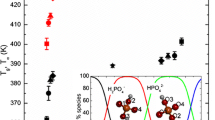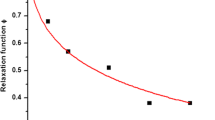Abstract
Purpose. To investigate chemical reactivity in water soluble glasses.
Methods. Rates of bond cleavage reactions in freeze-dried and freeze-concentrated aqueous carbohydrate solutions were measured above and below the glass transition temperatures (Tg). The kinetics of two reactions have been determined in formulations containing di- and polysaccharides: (1) fission of the Asp-Pro peptide bond in Physalaemin and Hamburger peptide by following the release of proline, using a ninhydrin based reaction and (2) the unimolecular dissociation of 2-(4-nitrophenoxy) tetrahydropyran by following the release of the 4-nitrophenoxy anion.
Results. The results show clearly that reaction occurs below the glass transition temperature, albeit at very reduced rates. No significant enhancement of the temperature dependence of the rate constant was observed near Tg. Different water soluble glasses provide different degrees of stability. The order of stabilisation was sucrose> Ficoll (low mol. weight)> Byco A ≅ Ficoll (high mol. weight)> dextran. The density of the matrix, and therefore the degrees of freedom of mobility of the reactant, is thought to be responsible for these differences.
Conclusions. The storage of therapeutic agents, such as proteins, in glassy matrices below Tg does not confer indefinite stability. When formulating products, notice should be taken of the differing stabilisation properties of excipients.
Similar content being viewed by others
REFERENCES
F. Franks. Conformational stability of proteins. In F. Franks (ed.), Protein Biotechnology, Humana Press, Totowa NJ, 1993, pp. 395-436.
G. Georgiou and E. De Bernandez-Clark. Protein Refolding ACS Symp. Ser. 470: (1991).
L. Slade and H. Levine. The glassy state phenomenon in food molecules. In J. M. V. Blanshard and P. J. Lillford, (eds.). The Glassy State in Foods, Nottingham University Press, 1993, pp. 35-102.
F. Franks. Long-term stabilization of biologicals. Bio/Technology 12:253-256 (1994).
M. J. G. W. Roozen, M. A. Hemminga, and P. Walstra. Molecular motion in glassy water-malto-oligosaccharide (maltodextrin) mixtures as studied by conventional and saturation-transfer spin-probe ESR spectroscopy. Carbohydrate Res. 215:229-237 (1991).
D. Girlich and H.-D. Lüdemann. Molecular mobility of sucrose in aqueous solution studied by 13C-nmr relaxation. Z. Naturforsch. 48c:407-413 (1993).
R. H. M. Hatley and F. Franks. Stable enzymes by water removal. In W. J. van den Tweel and R. M. Buitelaar, (eds.), Stability and Stabilization of Enzymes, Elsevier, Amsterdam, 1993, pp. 45-54.
M. J. Pikal, private communication.
F. Franks. Solid aqueous solutions. Pure & Appl. Chem. 65:2527-2537 (1993).
W. Kauzmann. The nature of the glassy state and the behavior of liquids at low temperatures. Chem. Rev. 43:219-256 (1948).
S. P. Ding, J. Fan, J. L. Green, Q. Lu, E. Sanchez, and C. A. Angell. Vitrification of trehalose by water loss from its crystalline dihydrate. J. Thermal Anal. 47:1391-1405 (1996).
F. Marcus. Preferential cleavage at aspartyl-prolyl peptide bonds in dilute acid. Int. J. Peptide Protein Res. 25:542-546 (1985).
D. Piszkiewicz, M. Landon, and E. L. Smith. Anomalous cleavage of aspartyl-proline peptide bonds during amino acid sequence determinations. Biochem. Biophys. Res. Comm. 40:1173 (1970).
J. R. Haak and J. B. F. N. Engberts. Solvent effects on the spontaneous hydrolysis of 2-(aryloxy)tetrahydropyrans in some water-rich, typically nonaqueous solutions. J. Org. Chem. 49:2387-2391 (1984).
F. Franks. Effective freeze-drying: A combination of physics, chemistry, engineering and economics. Proc. Inst. Refrig. 91:32-39 (1994–5).
E. Yu. Shalaev and F. Franks. Structural glass transitions and thermophysical processes in amorphous carbohydrates and their supersaturated solutions. J. Chem. Soc. Faraday Trans. 91:1511-1517 (1995).
C. A. Angell. Formation of glasses from liquids and biopolymers. Science 267:1924-1935 (1995).
T. H. Fife and L. K. Jao. General acid catalysis of acetal hydrolyses. The hydrolysis of 2-aryloxytetrahydropyrans. J. Am. Chem. Soc. 90:4081-4085 (1968).
F. Franks. Freeze-drying: From empiricism to predictability. Cryo-Letters 11:93-110 (1990).
W. Troll and R. K. Cannan. A modified photometric ninhydrin method for the analysis of amino and imino acids. J. Biol. Chem. 200:803-811 (1953).
L. Slade and H. Levine. A food polymer science approach to structure-property relationships in food systems: Non-equilibrium behaviour of carbohydrate-water systems. In H. Levine and L. Slade (eds.). Water Relationships in Foods, Plenum Press, New York, 1991, pp 29-101.
R. H. M Hatley and A. Mant, Determination of the unfrozen water content of maximally freeze-concentrated carbohydrate solutions. Int. J. Biol. Macromol. 15:227-232 (1993).
C. Oliyai, J. P. Patel, L. Carr, R. T. Borchardt. Chemical pathways of peptide degradation. VII. Solid state chemical instability of an aspartyl residue in a model hexapeptide. Pharm. Res. 11:901-908 (1994).
Author information
Authors and Affiliations
Rights and permissions
About this article
Cite this article
Streefland, L., Auffret, A.D. & Franks, F. Bond Cleavage Reactions in Solid Aqueous Carbohydrate Solutions. Pharm Res 15, 843–849 (1998). https://doi.org/10.1023/A:1011912228954
Issue Date:
DOI: https://doi.org/10.1023/A:1011912228954




